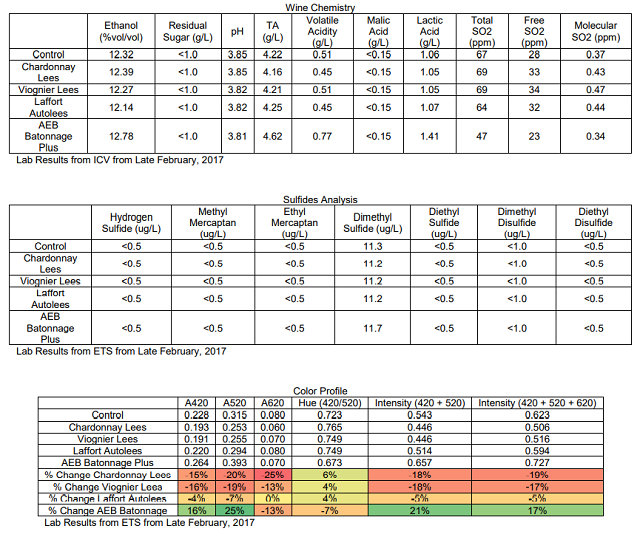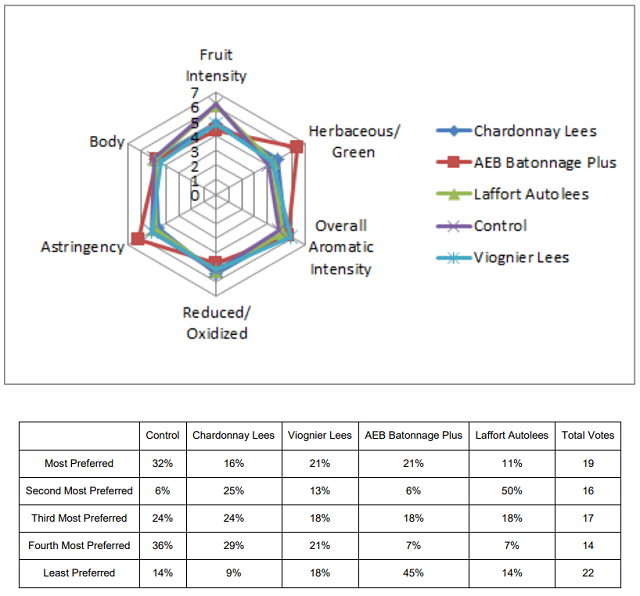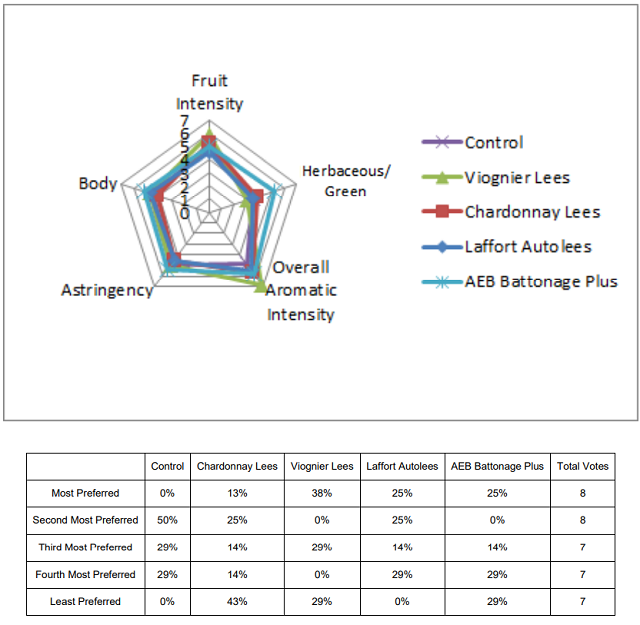The Effect of Different Sources of Lees and Lees Products on Aging Cabernet Franc Wine (2016)
Theo Smith
Rappahannock Cellars
Summary
This study examines the impact of adding different sources of lees to aging Cabernet Franc wine. Cabernet Franc wine was split into 5 barrels with the following treatments: 1) no lees addition, 2) 2 pints of Chardonnay lees added, 3) 2 pints of Viognier Lees added, 4) Laffort Autolees added, and 5) AEB Batonnage Elevage added. The wines were stirred once every two weeks until taken for sampling (in February). Wine chemistry did not differ between treatments. The sulfide profile did not differ at the limit of detection of the laboratory analyses. All treatments slightly lowered color intensity and increased hue, except for the AEB Batonnage treatment, which increased color intensity and decreased hue. In the first tasting, the Control and the Laffort Autolees treatment strongly increased Fruit Intensity, but this was not replicated at the second tasting. There were weaker tendencies between tastings, however. Lees which originated from wine (Viognier and Chardonnay Lees) appeared to have a consistent impact on the aroma of the wines, whereas lees which originated from products had less impact on wine aroma. An exception would be the AEB Battonage Plus treatment, which appeared to increase Herbaceous/Green qualities. The AEB lees tended to have the largest impact on Astringency. No major preference trends could be seen. These results were very mixed, likely due in part to the complexity of the project. This project produced interesting results, and more work on the impact of lees management in red wines should be done before drawing hard conclusions about these different lees sources. Stylistic possibilities of adding aromatic white wine lees to red wine should also be considered in future studies.
Introduction
Red wines are often harsh when young, and need time for the tannin to integrate into the wine and become more round. For this reason, red wines are often barrel aged. In addition to the impact of the barrel and oxygenation on the tannin development of wine, the effect of lees can also impact the roundness and astringency of red wines. Sur lies aging releases mannoproteins and other cell wall polysaccharides which can enhance the colloidal structure, stability, and aromatic quality of red wines while reducing their astringency, making sur lie aging of red wines important (Zoecklein 2005). As such, it is of interest to investigate the impact of different sources of lees on the sensory and chemical characteristics of red wines. This study examines the impact of these products on Cabernet Franc wine.
Results and Discussion
Wine chemistry did not differ between treatments. The sulfide profile did not differ at the limit of detection of the laboratory analyses. All treatments slightly lowered color intensity and increased hue, except for the AEB Batonnage treatment, which increased color intensity and decreased hue.


For the April 12 tasting, descriptive analysis showed a strong trend for the Control wine and the Laffort Autolees wine to have higher Fruit Intensity than the rest. This may be due to a neutrality in the Laffort Autolees not negatively impacting Fruit Intensity, which was not present in the other lees sources. No other strong trends emerged, but the AEB Batonnage Plus treatment tended to have higher Herbaceous/Green and Astringency scores. In general, no major preference for most preferred lees product could be seen. Laffort Autolees was the second-most preferred, and AEB Batonnage Plus was the least preferred.

No strong trends could be seen with the descriptors used for the May 17 tasting. There was a slight tendency for Viognier Lees to increase Overall Aromatic Intensity, and AEB Battonage Plus to increase Herbaceous/Green character, Astringency, and Body. Viognier and Chardonnay Lees both seemed to slightly increase Fruit Intensity. There was reason to believe that the “Reduced/Oxidized” descriptor was used incorrectly, and so it was eliminated. No strong preferences could be seen between treatments, except that Chardonnay lees tended to be preferred the least.

In the first tasting, the Control and the Laffort Autolees treatment strongly increased Fruit Intensity, but this was not replicated at the second tasting. There were weaker tendencies between tastings, however. Lees which originated from wine (Viognier and Chardonnay Lees) appeared to have a consistent impact on the aroma of the wines, whereas lees which originated from products had less impact on wine aroma. An exception would be the AEB Battonage Plus treatment, which appeared to increase Herbaceous/Green qualities. The AEB lees tended to have the largest impact on Astringency. These results were very mixed, likely due in part to the complexity of the project. This project produced interesting results, and more work on the impact of lees management in red wines should be done before drawing hard conclusions about these different lees sources. Stylistic possibilities of adding aromatic white wine lees to red wine should also be considered in future studies.
Methods
Cabernet Franc grapes were sourced from Littleway Vineyard on 10/4, had a 25% saignée, and was fermented with CVRP yeast and underwent malolactic conversion. Once the wine had finished fermentation and malolactic conversion (10/31) it was stabilized with 60ppm sulfur dioxide. On 11/16 the wine was racked to identical neutral French oak barrels. On 11/20 the following treatments were performed:
- BBL 1: Control
- BBL 2: Chardonnay Lees 2 pints
- BBL 3: Viognier Lees 2 pints
- BBL 4: Laffort AutoLees
- BBL 5: AEB Battonage Elevage
Lees from Chardonnay and Viognier were harvested from wines produced earlier in the season, allowed to settle, and the lighter lees (on top) were then used as the exogenous lees source so long as they did not taste sour or unusual. The wines were stirred once every two weeks until taken for sampling.
This project was tasted on April 12 and May 17. In order to balance the data set to perform statistical analysis for descriptive analysis on the April 12 tasting, any judge who had not fully completed the descriptive analysis ratings were removed. In order to then make the number of judges between groups equivalent, one judge from group 2 was transferred to group 1, and another judge from group 1 was eliminated. This judge was eliminated because it appeared that they suffered from severe palate fatigue (since these wines were very different and they rated them all as essentially the same). This resulted in a final data set of 3 groups, each with 5 judges (considered as replications within groups, and groups were considered as assessors). Data was analyzed using Panel Check V1.4.2. Because this is not a truly statistical set-up, any results which are found to be statistically significant (p<0.05) will be denoted as a “strong trend” or a “strong tendency,” as opposed to general trends or tendencies. The statistical significance here will ignore any other significant effects or interactions which may confound the results (such as a statistically significant interaction of Judge x Wine confounding a significant result from Wine alone). The descriptors used in this study were Fruit Intensity, Herbaceous/Green, Overall Aromatic Intensity, Reduced/Oxidized (on a scale from most reduced to most oxidized, with the middle being balanced), Astringency, and Body.
The same procedures for data analysis were used on the May 17 tasting. For the descriptive analysis in this tasting, each group had two judges, for a total of 6 judges (one judge had to be removed from Group 3 to balance the data set).
References
Zoecklin, B. 2005. Lees Management. Enology Notes #106. http://www.apps.fst.vt.edu/extension/enology/EN/106.html.
